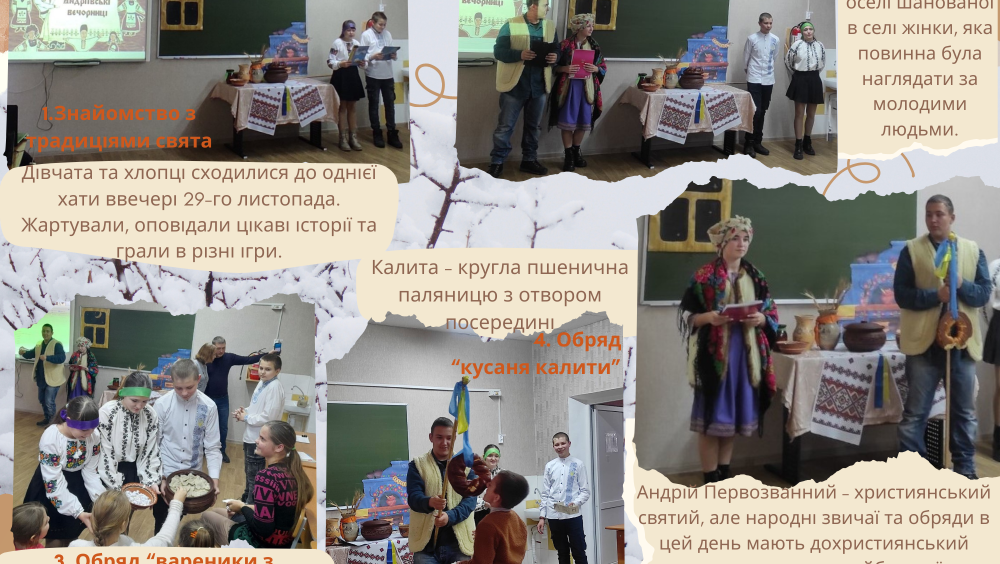St. Andrew's Vespers
Folk traditions are an integral part of every nation. Traditions are our historical heritage, our past that embodies the spiritual treasures of the nation. Thanks to traditions, we learn about the peculiarities of our ancestors' lives. And it was with the aim of reviving the heritage of our ancestors that we decided to organize an event called "St. Andrew's Evenings" at our school.
The purpose of our "St. Andrew's Evenings" was not only to explore the past of our ancestors, but also to demonstrate a part of this past in the form of evening parties. By paying homage to the past we revive all the most precious things that the people have: their language, songs, history, rituals...
St. Andrew's evenings are one of the most interesting Ukrainian traditions that have reached our time through the ages. St. Andrew's Day we celebrate on the 30th of November. According to ancient chronicles, it was he who brought Christianity to the Slavic peoples. Although Andrew Pervozvanyi is a Christian saint, folk customs and rituals on this day are pre-Christian in nature: fortune-telling, incantations, and ritual biting of the "kalyta".
In preparation for the holiday, we arranged the "svitlytsia" - the main room of the Ukrainian house; we "made" a stove, set the table with dishes of our ancestors, cooked dumplings with predictions and interesting flavors, and baked kalyta.
We prepared for the holiday parties together. According to the traditions of our ancestors, girls and boys would gather in one house on the evening of November 29. They would joke, tell interesting stories and play various games, and on the night of November 29-30, they would tell fortunes... As a rule, the parties were held in the house of a woman respected in the village, whom all the visitors called "vechernychna", "experienced mother", "panimatka". The woman was supposed to look after the young people, and parents could safely let their children go to her house for the parties. The young people were unmarried. To thank the hostess, the boys and girls helped her with the housework and left her goodies after the celebrations.
Beforehand, the young people would bring flour, cereals, dried apples and pears to a hostess. The girls would gather early, before sunset, so that they could prepare treats together before the boys arrived, cook a joint dinner, and, most importantly, bake Kalyta, a round wheat cake with a hole in the middle or side. The older woman also taught them how to cook, embroider or spin, and often instructed the younger ones, giving them life advice. They could ask her anything they could not talk to their mother about.
During dinner parties, the boys would usually get up to mischief. They could tie the door so that the girls could not leave the house, throw water on them or scare them. If the parents did not let the girl go to the party, the boys would smear soot on their windows, pull a cart onto the roof, or run around the yard. On this evening, whatever the boys did, they were forgiven, because there is a tradition that every boy "caper" on St. Andrew's Day. The parties took place late in the evening. So at the end of the party, the boys would walk the girls home.
And, of course, there was fortune telling. On the night before the holidays, girls would tell fortunes to find out whether they would get married next year, where their groom would come from, and whether they would have a happy life. Usually, boys would interfere with the girls' divination. They could do it for fun. Or if a boy liked a particular girl and wanted the fortune teller to point to him.
An integral part of St. Andrew's evening is the ritual of "biting the Kalyta". Mr. Kalytynsky held the kalyta during the vespers. Young people would try to bite off a piece of it by riding a kotsiuba, an iron rod used to rake the heat out of the oven. The kotsiuba symbolized a horse. Of course, this had to be done without the help of hands. Those who were unable to bite off the kalyta would have their mustaches painted with soot or sour cream. This was also part of the entertainment, accompanied by laughter and joking sayings.
The young people gathered for the parties because it was an opportunity to have fun when the work in the fields was over, as well as a chance to meet and find a mate.
Our St. Andrew's parties at school gave us the opportunity to learn about the ancient traditions and culture of our ancestors. We study the history of the Ukrainian people, which is an integral part of European history.
